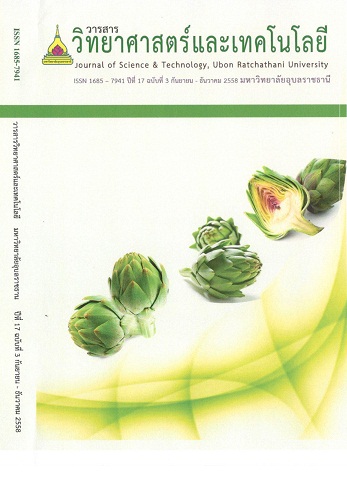Influences of Different Soup Stocks on Chemical and Organoleptic Properties of Tom Yum
Main Article Content
บทคัดย่อ
‘Tom Yum,’ a delicious Asian soup originating from Thailand, has been widely known as one of the most popular foods among Thais and foreigners. Bundles of fresh herbs are normally added into soup stock of Tom Yum and a choice of meat is usually shrimp or prawn. Tom Yum (TY) can be classified into two types which are Tom Yum Nam Sai (TYNS) and Tom Yum Nam Khon (TYNK). This research aimed to develop recipes (TYNS and TYNK) as well as to report the health aspects based on the chemical and organoleptic properties including consumer acceptability of TYs. The TY recipes were developed by a famous master-chef of Thai foods with over three decades of experience in the creation of an authentic taste of TYs who has worked with food industries around the world. For each TY recipe, three kinds of stock, (1) still water, (2) stock made from shrimp shells, and (3) stock made from chicken bones, were investigated in TYNS recipe. Another three kinds of stock, (1) stock with added evaporated milk, (2) stock with added coconut milk, and (3) stock with added whipping cream plus coconut milk were investigated in TYNK recipe. Three of each TY recipe were selected using 9-point hedonic scale by twenty professional panelists in Thai food. Overall liking scores of TYNS and TYNK were rated “like moderate” at 6.35 and 7.40 respectively. For TYNS, three out of nine attributes had significant differences, TY herbs aroma (p=0.024), TY flavor (p=0.088), and hot (p=0.075). For TYNK, all studied attributes had significant differences (p0.001) except salty (p=0.013). The developed recipes were repeated for consumer acceptability. Two hundred consumers rated them using a 9-point hedonic scale. The consumer acceptability was in relation to a previous study rated by the professional panelists. TYNS and TYNK performed nil trans fat (not detected), low sodium chloride (0.67 and 1.10g/ 100g), low total energy (32.18 and 41.20 kcal/ 100g), high glutamic acid (656.93 and 772.52 mg/ 100g) and antioxidant values (17.55 and 25.44 mg eq/ Trolox/ 100g). Both TY recipes, as a consequence, can be identified as healthy nutritional soups due to the positive chemical properties and Tom Yum can be promoted as healthy for consumers.
ต้มยำเป็นอาหารไทยที่มีชื่อเสียงเป็นที่รู้จักกันอย่างแพร่หลายทั้งในกลุ่มคนไทยและคนต่างชาติ สมุนไพรหลายชนิดถูกนำมาใช้เพื่อทำน้ำซุปต้มยา เนื้อสัตว์ที่นิยมใส่ในต้มยำคือกุ้งสด ต้มยำแบ่งเป็น 2 ประเภทหลัก ได้แก่ ต้มยำน้ำใส (TYNS) และต้มยำน้ำข้น (TYNK) งานวิจัยนี้มีวัตถุประสงค์เพื่อพัฒนาสูตรต้มยำน้ำใสและน้ำข้น พร้อมกับรายงานคุณค่าทางสุขภาพของต้มยำ ผลทางเคมีและประสาทสัมผัส รวมทั้งการยอมรับของผู้บริโภคต่อผลิตภัณฑ์ ต้มยำทั้งสองสูตรได้รับการพัฒนาจากเชฟผู้เชี่ยวชาญอาหารไทยที่มีชื่อเสียง ซึ่งอยู่ในวงการนานกว่า 30 ปี สูตรน้ำซุปที่ศึกษาสำหรับต้มยำน้ำใส 3 ชนิด คือ (1) น้ำเปล่า (2) น้ำต้มเปลือกกุ้ง และ (3) น้ำต้มกระดูกไก่ สำหรับต้มยำน้ำข้น ชนิดน้ำซุปที่ศึกษา 3 ชนิด คือ (1) น้ำต้มเปลือกกุ้งเติมด้วยนมข้นจืด (2) น้ำต้มเปลือกกุ้งเติมด้วยน้ำกะทิ และ (3) น้ำต้มเปลือกกุ้งเติมด้วยวิปปิ้งครีมผสมน้ำกะทิ ทั้งสามสูตรของต้มยำแต่ละชนิดถูกคัดเลือกด้วยการประเมินความชอบแบบ 9-point hedonic scale โดยใช้ผู้ทดสอบที่ผ่านการฝึกฝนจำนวน 20 คน ผลที่ได้พบว่า ต้มยำน้ำใสและน้ำข้นได้รับคะแนนความชอบโดยรวมระดับชอบปานกลาง เท่ากับ 6.35 และ 7.40 ตามลำดับ สำหรับต้มยำน้ำใส กลิ่นสมุนไพร (p=0.024) กลิ่นรสสมุนไพร (p=0.088) และความเผ็ด (p=0.075) เป็นสามคุณลักษณะที่แตกต่างกันอย่างมีนัยสำคัญทางสถิติ ในขณะที่ทุกคุณลักษณะที่ศึกษาในต้มยำน้ำข้นมีความแตกต่างกันอย่างมีนัยสำคัญทางสถิติ (p0.001) รวมทั้งเกลือด้วย (แต่แตกต่างกันเพียง p=0.013) ต้มยำที่ได้รับคะแนนความชอบสูงสุดจากทั้งสองสูตรนำมาศึกษาการยอมรับจากผู้บริโภคทั่วไปจำนวน 200 คน ด้วยการประเมินความชอบแบบ 9-point hedonic scale ผลตอบรับของต้มยำทั้งสองสูตรเป็นที่น่าพอใจและสอดคล้องกับการทดลองก่อนหน้านี้ที่ใช้ผู้ทดสอบที่ผ่านการฝึกฝน ผลทางเคมีไม่พบไขมันชนิดทรานส์ในต้มยำทั้งสองสูตรที่พัฒนาได้ (TYNS และ TYNK) มีเกลือโซเดียมคลอไรด์เล็กน้อย (0.67 และ 1.10 กรัม/ 100 กรัม) ให้พลังงานน้อย (32.18 และ 41.20 กิโลแคลอรี/ 100กรัม) ให้กรดกลูตามิคมาก (656.93 และ 772.52 มิลลิกรัม/ 100กรัม) ทั้งยังมีค่าการต้านอนุมูลอิสระเป็นบวก (17.55 และ 25.44 เทียบเท่ามิลลิกรัม/ โทรลอค/ 100กรัม) ดังนั้นต้มยำจึงถือว่าเป็นอาหารเพื่อสุขภาพที่ควรได้รับการส่งเสริมประชาสัมพันธ์ต่อไป
Article Details
บทความที่ได้รับการตีพิมพ์เป็นลิขสิทธิ์ของ วารสารวิทยาศาสตร์และเทคโนโลยี มหาวิทยาลัยอุบลราชธานี
ข้อความที่ปรากฏในบทความแต่ละเรื่องในวารสารวิชาการเล่มนี้เป็นความคิดเห็นส่วนตัวของผู้เขียนแต่ละท่านไม่เกี่ยวข้องกับมหาวิทยาลัยอุบลราชธานี และคณาจารย์ท่านอื่นๆในมหาวิทยาลัยฯ แต่อย่างใด ความรับผิดชอบองค์ประกอบทั้งหมดของบทความแต่ละเรื่องเป็นของผู้เขียนแต่ละท่าน หากมีความผิดพลาดใดๆ ผู้เขียนแต่ละท่านจะรับผิดชอบบทความของตนเองแต่ผู้เดียว


